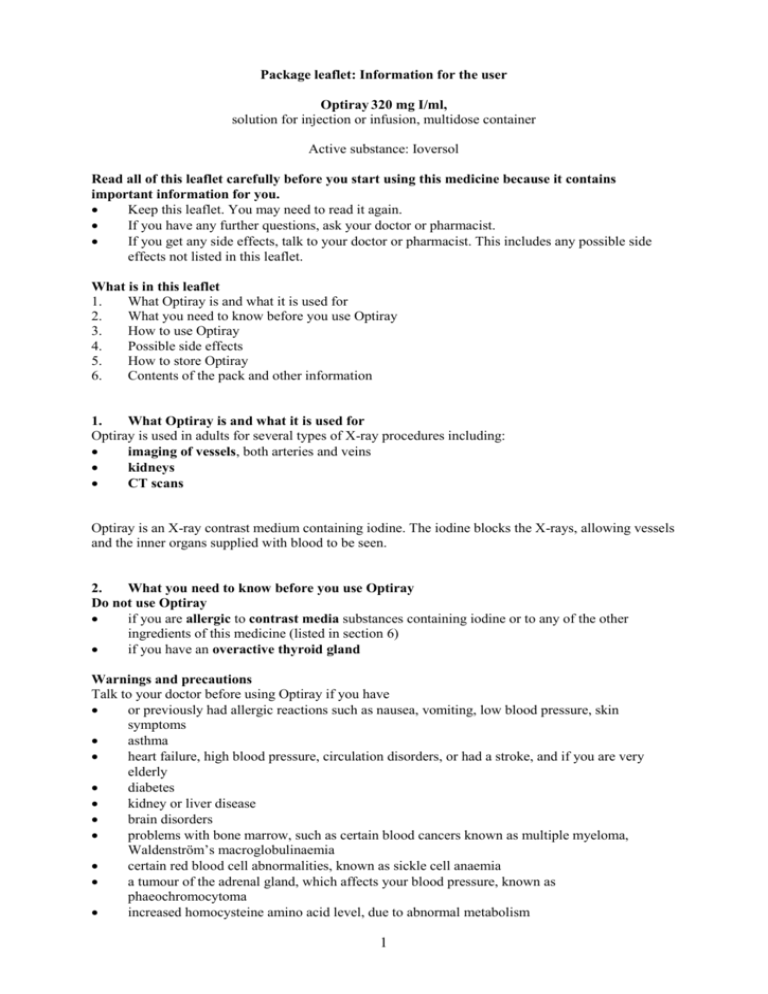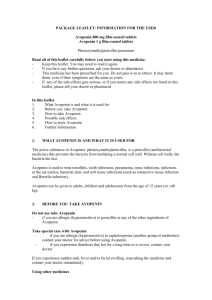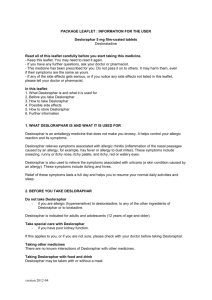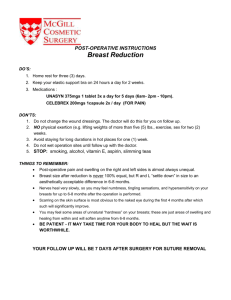3. How to use Optiray
advertisement

Package leaflet: Information for the user Optiray 320 mg I/ml, solution for injection or infusion, multidose container Active substance: Ioversol Read all of this leaflet carefully before you start using this medicine because it contains important information for you. Keep this leaflet. You may need to read it again. If you have any further questions, ask your doctor or pharmacist. If you get any side effects, talk to your doctor or pharmacist. This includes any possible side effects not listed in this leaflet. What is in this leaflet 1. What Optiray is and what it is used for 2. What you need to know before you use Optiray 3. How to use Optiray 4. Possible side effects 5. How to store Optiray 6. Contents of the pack and other information 1. What Optiray is and what it is used for Optiray is used in adults for several types of X-ray procedures including: imaging of vessels, both arteries and veins kidneys CT scans Optiray is an X-ray contrast medium containing iodine. The iodine blocks the X-rays, allowing vessels and the inner organs supplied with blood to be seen. 2. What you need to know before you use Optiray Do not use Optiray if you are allergic to contrast media substances containing iodine or to any of the other ingredients of this medicine (listed in section 6) if you have an overactive thyroid gland Warnings and precautions Talk to your doctor before using Optiray if you have or previously had allergic reactions such as nausea, vomiting, low blood pressure, skin symptoms asthma heart failure, high blood pressure, circulation disorders, or had a stroke, and if you are very elderly diabetes kidney or liver disease brain disorders problems with bone marrow, such as certain blood cancers known as multiple myeloma, Waldenström’s macroglobulinaemia certain red blood cell abnormalities, known as sickle cell anaemia a tumour of the adrenal gland, which affects your blood pressure, known as phaeochromocytoma increased homocysteine amino acid level, due to abnormal metabolism 1 recent gall bladder investigation with contrast media a planned thyroid gland investigation using a substance containing iodine This should be postponed as Optiray may influence results for up to 16 days. Children younger than 18 years Optiray 320 is not recommended in this age group. Other medicines and Optiray Tell your doctor or X-ray specialist if you are using, have recently used or might use any other medicines. The following medicines can influence or be influenced by Optiray metformin: a medicine to treat diabetes Your doctor will measure your kidney function before and after Optiray use. Metformin should be stopped before the investigation. It should not be re-started for at least 48 hours after the investigation and only when your kidney function has returned to its previous level. interleukin: medicines to treat certain tumours certain medicines to increase blood pressure due to narrowing of blood vessels To prevent any risk of nervous disorders, Optiray should never be used while using these medicines. general anaesthetics A higher frequency of side effects has been reported. Pregnancy and breast-feeding Pregnancy Tell your doctor if you are pregnant or think you could be. Your doctor will only administer Optiray during pregnancy if it is absolutely necessary, as it could harm the unborn child. Breast-feeding Discontinue breast-feeding for one day after the injection, as insufficient information exists concerning safety. Discuss this with your doctor or X-ray specialist. Driving and using machines Driving or operating machines is not advisable for up to 1 hour after injection. In addition, symptoms such as dizziness, drowsiness, fatigue and visual disturbances have been reported. If this affects you, do not attempt any activities which require concentration and the ability to react appropriately. 3. How to use Optiray Optiray investigations will only be performed by a doctor or X-ray specialist, who will also decide the dose. Optiray is injected into a blood vessel and distributed throughout the body by the blood stream. It will be warmed to body temperature before use, then injected once or more during the X-ray procedure. The dose depends on the specific procedure you are having and other factors such as your health and age. The lowest dose possible will be used to produce adequate X-ray images. If more Optiray is given than it should Overdoses are potentially dangerous and may affect the breathing, heart and circulation system. Inform your doctor or X-ray specialist immediately if you notice any of these symptoms after receiving Optiray. If you have any further questions on the use of this medicine, ask your doctor or X-ray specialist. 2 4. Possible side effects Like all medicines, this medicine can cause side effects, although not everybody gets them. Side effects associated with Optiray are generally independent of the dose given. In the majority of cases they are mild or moderate and very rarely serious or life-threatening. Inform your doctor immediately if you develop any of the following signs of serious side effects: heart or breathing arrest heart vessel spasms or blood clots stroke, blue lips, fainting loss of memory speech disorders sudden movements temporary blindness acute kidney failure severe skin break-down signs of allergic reactions, such as - allergic shock - tightened airways - swelling of the voice box, throat, tongue - breathing difficulties - cough, sneezing - reddening and/or swelling of the face and eyes - itching, rash and hives Side effects can occur with the following frequencies: very common, occurs in more than 1 of 10 users feeling hot common, occurs in 1 to 10 per 100 users pain uncommon, occurs in 1 to 10 per 1,000 users nausea hives rare, occurs in 1 to 10 per 10,000 users fainting uncontrollable shaking dizziness, light-headedness headache abnormal sensation, such as pricking, tingling taste disturbance blurred vision racing pulse low blood pressure flushing larynx cramps swelling and narrowing of airways, including throat tightness, wheezing difficult breathing inflammation inside the nose which causes sneezing and blocked nose cough, throat irritation vomiting dry mouth skin redness, itching, rash urgent urination 3 swelling of the face including eyes chills, feeling cold very rare, occurs in fewer than 1 per 10,000 users severe allergic reaction confusion, anxiety, restlessness loss of consciousness, numbness paralysis drowsiness speech disorders reduced sense of touch or sensation allergic eye inflammation causing red, watery and itchy eyes ringing or buzzing in the ears irregular heartbeats, slow pulse chest pain heart activity changes measured using ECG disease which disturbs blood flow through the brain high blood pressure vein inflammation, blood vessel dilation fluid accumulation in the lung sore throat low oxygen in the blood abdominal pain salivary gland inflammation, swelling of the tongue difficulty in swallowing, increased salivation mostly painful severe swelling of deep skin layers, mainly in the face increased sweating muscle cramps acute kidney failure or abnormal kidney function urinary incontinence, blood in urine tissue swelling caused by excess fluid injection site reactions including pain, reddening, bleeding or degeneration of cells feeling unwell or abnormal, tiredness, sluggishness not known: frequency cannot be estimated from the available data severe allergic shock reaction temporarily underactive thyroid in newborns fits movement disorder loss of memory temporary blindness heart arrest, life-threatening irregular heartbeat extra heartbeat heart artery cramps, pounding of the heart blue skin colouration due to low oxygen in the blood shock blood clot or spasm in a blood vessel breathing arrest, asthma, tightened airways reduced ability to produce voice sounds using the vocal organs diarrhoea mild to severe inflammatory skin rash, sometimes with fever and blisters pallor absent or painful/difficult urination fever 4 If you get any side effects, talk to your doctor or X-ray specialist. This includes any side effects not listed in this leaflet. You can also report side effects directly via the national reporting system listed in Appendix V. By reporting side effects you can help provide more information on the safety of this medicine. 5. How to store Optiray Keep this medicine out of sight and reach of children. Do not use this medicine after the expiry date which is stated on the label. The expiry date refers to the last day of that month. Keep the container in the outer carton in order to protect from light. Protect from X-rays. Do not store above 30°C. Optiray 320 can be stored for one month at 37°C in a contrast media warmer with circulating air. Do not use this medicine if you notice discolouration or particulate matter. 6. Contents of the pack and other information What Optiray contains The active substance is Ioversol. One millilitre of Optiray contains 678 mg Ioversol, which is equal to 320 mg of organically bound iodine. The other ingredients are sodium calcium edetate (stabiliser), trometamol and trometamol hydrochloride (buffer), and water for injections. Sodium hydroxide and hydrochloric acid may be used for adjustment pH of 6.0 to 7.4. What Optiray looks like and contents of the pack Optiray is packaged in uncoloured bottles. Bottles are fitted with 32 mm bromobutyl rubber closures and aluminium cap seals. Pack sizes: 1x500 ml and 5x500 ml, respectively. Not all pack sizes and box sizes may be marketed in all countries. Marketing Authorisation Holder and Manufacturer Marketing Authorisation Holder <[To be completed nationally]> Manufacturer Mallinckrodt Medical Imaging Ireland, Damastown, Mulhuddart, Dublin 15, Ireland This leaflet was last revised in 2015-03-18 The following information is intended for medical or healthcare professionals only: Special warnings and precautions for use Serious or fatal reactions have been associated with the administration of iodinated X-ray contrast media. It is important to be prepared to treat any contrast medium reaction. Such procedures, which involve the use of iodinated intravascular agents, should be performed under the direction of personnel skilled and experienced in the particular procedure to be performed. A fully equipped emergency cart, or equivalent supplies and equipment, and personnel competent in 5 recognising and treating adverse reactions of all types should always be available. Since severe delayed reactions have been known to occur, the patient should be observed and emergency facilities and competent personnel should be available for at least 30 to 60 minutes after administration. The anticoagulant effect of non-ionic X-ray contrast media has been shown, in vitro, to be less than that of conventional ionic agents at comparable concentrations. Similar results were found in some in vivo studies. For this reason, meticulous angiographic techniques are recommended, e.g. frequent flushing of standard angiographic catheters and avoiding prolonged contact of blood with the contrast agent in syringes and catheters. Optiray should be injected with caution to avoid perivascular application. Serious tissue damage (e.g. ulceration) has been reported in isolated cases requiring surgical treatment. Incompatibilities No other medicinal product should be mixed with Optiray. Administration Optiray 500 ml bottles must only be used with administration devices, e.g. infusion pumps or dual head injectors which are provided with reliable connecting tubes. Optiray 500 ml bottles have a rubber stopper which can only be pierced once. The manufacturer’s instructions for the device must be followed. Shelf life Any Optiray in 500 ml bottles which is unused at the end of the day must be discarded. 6








